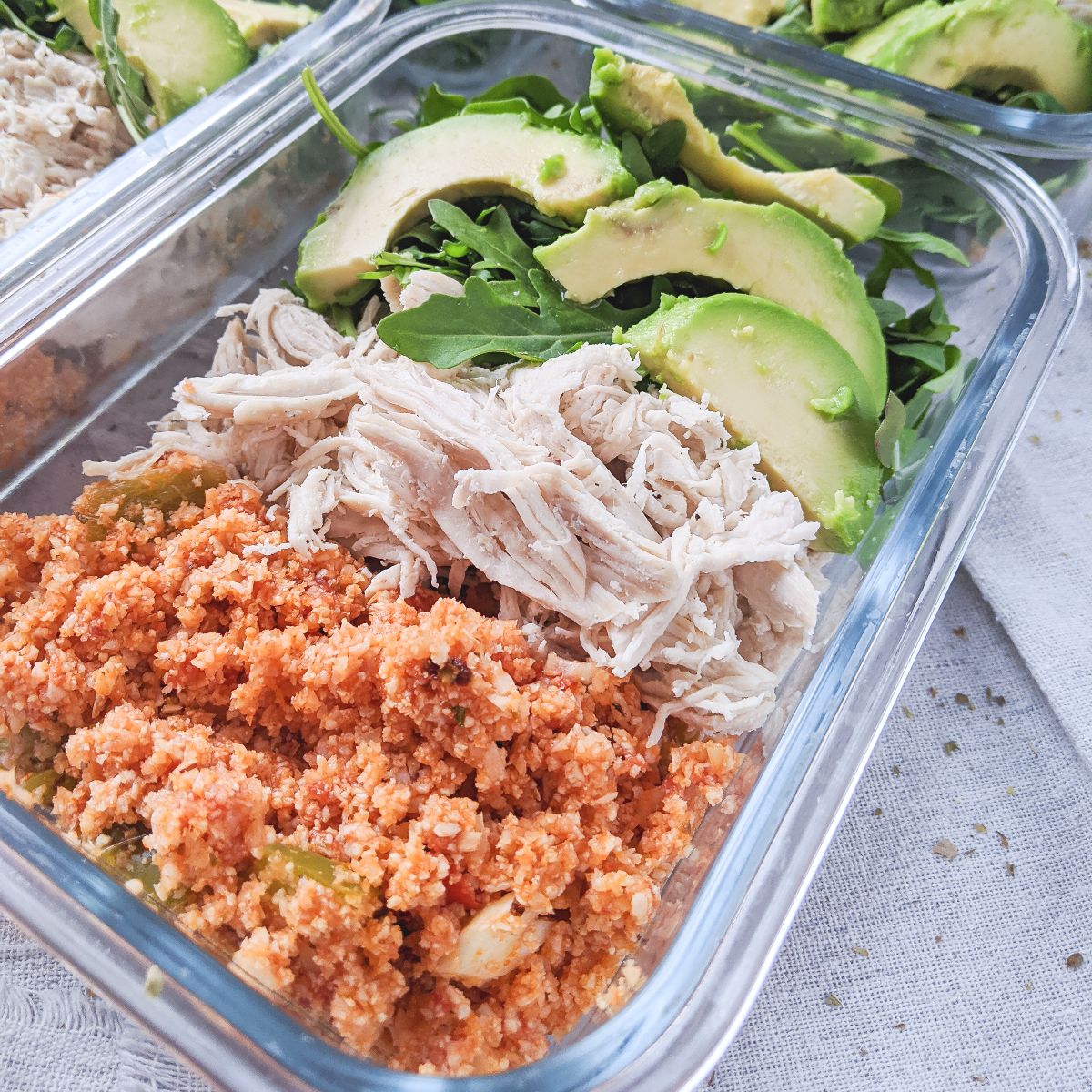Conquer your week with vibrant, delicious low-carb meals! Imagine a fridge stocked with flavorful, ready-to-eat dishes, all meticulously planned and prepared in advance. This isn’t about bland, restrictive diets; it’s about mastering the art of efficient meal prep to fuel your body with satisfying, low-carb goodness. Discover diverse recipes – from protein-packed breakfasts to quick lunches and satisfying dinners – designed for batch cooking, saving you time and effort without sacrificing taste or nutrition.
This guide dives deep into the world of low-carb batch cooking, offering a treasure trove of recipes, tips, and techniques to transform your weekly meal planning. We’ll explore strategic ingredient selection, efficient cooking methods, and smart storage solutions, all while ensuring your meals remain fresh, flavorful, and nutritionally balanced. Prepare to elevate your low-carb journey with a streamlined approach to delicious, healthy eating.
High-Protein Low-Carb Breakfasts for Meal Prep
Starting your day with a high-protein, low-carb breakfast sets the stage for successful low-carb meal prepping. These breakfasts keep you feeling full and energized, preventing those mid-morning energy crashes and cravings that can derail your diet. Proper meal preparation ensures you have convenient and healthy options readily available, minimizing the temptation to reach for less-healthy choices.
High-Protein Low-Carb Breakfast Recipes
The following recipes are designed for batch cooking, allowing you to prepare several servings at once for a week’s worth of breakfasts. They are versatile and can be adapted to your preferences. Remember to adjust portion sizes according to your individual caloric needs.
| Name | Ingredients | Instructions Summary | Nutritional Info (per serving) |
|---|---|---|---|
| Egg & Cheese Muffin Cups | 6 large eggs, 1/2 cup shredded cheddar cheese, 1/4 cup chopped spinach, 1/4 cup chopped bell pepper, salt and pepper to taste | Whisk eggs. Mix in cheese, spinach, and pepper. Divide evenly among greased muffin tins. Bake at 350°F (175°C) for 15-20 minutes until set. | Approx. 200 calories, 15g protein, 12g fat, 2g carbs |
| Chia Seed Pudding with Berries | 1/4 cup chia seeds, 1 cup unsweetened almond milk, 1/4 cup mixed berries (strawberries, blueberries, raspberries), 1 tbsp sweetener (e.g., stevia or erythritol – optional) | Combine chia seeds and almond milk in a jar or container. Stir well. Add sweetener (if using). Refrigerate overnight or for at least 2 hours. Top with berries before serving. | Approx. 150 calories, 5g protein, 8g fat, 10g carbs (carbs will vary based on berry type and quantity) |
| Savory Oatmeal with Protein Powder | 1/2 cup unsweetened almond flour, 1 scoop unflavored protein powder, 1 cup unsweetened almond milk, 1/4 cup chopped mushrooms, 1/4 cup chopped cooked bacon, salt and pepper to taste | Combine almond flour, protein powder, and almond milk in a saucepan. Cook over medium heat, stirring constantly, until thickened. Stir in mushrooms and bacon. Season with salt and pepper. | Approx. 250 calories, 30g protein, 10g fat, 10g carbs (carbs will vary depending on protein powder type) |
Macronutrient Breakdown Infographic
The infographic displays the macronutrient breakdown (protein, fat, carbohydrates) of each breakfast recipe using a visually engaging pie chart design. Each recipe will have its own pie chart.
For the Egg & Cheese Muffin Cups, a vibrant yellow represents protein (15g), a rich orange symbolizes fat (12g), and a small, muted green section depicts carbohydrates (2g). The title “Egg & Cheese Muffin Cups” is written in a bold, sans-serif font (e.g., Arial Black) in dark brown.
The Chia Seed Pudding with Berries infographic utilizes a light blue for protein (5g), a deep purple for fat (8g), and a bright red for carbohydrates (10g). The title, “Chia Seed Pudding with Berries,” is in a script font (e.g., Edwardian Script ITC) in a deep berry color.
The Savory Oatmeal with Protein Powder infographic uses a deep green for protein (30g), a light beige for fat (10g), and a light brown for carbohydrates (10g). The title “Savory Oatmeal with Protein Powder” is in a bold, serif font (e.g., Times New Roman Bold) in a dark grey.
All three charts use clear, concise labels for each macronutrient, displayed directly on each slice of the pie chart. The background of the infographic is a light grey, providing contrast to the pie charts and text. A consistent font style is used throughout for a unified aesthetic.
Benefits of High-Protein Low-Carb Breakfasts
Incorporating high-protein, low-carb breakfasts into a low-carb meal prep plan offers several significant advantages. The high protein content promotes satiety, reducing hunger pangs and preventing overeating throughout the day. This helps in maintaining consistent energy levels, minimizing those mid-morning energy dips often associated with low-carb diets. Furthermore, adequate protein intake supports muscle mass preservation, crucial for overall health and metabolism. By preparing these breakfasts in advance, you save time and ensure you have a healthy and convenient option available each morning, making adherence to your low-carb plan significantly easier.
Quick & Easy Low-Carb Lunches for Busy Weekdays
Preparing low-carb lunches for busy weekdays doesn’t have to be a chore. With a little planning and these simple recipes, you can enjoy delicious and satisfying meals without sacrificing your time or your diet. These recipes focus on speed and simplicity, perfect for those short on time but committed to healthy eating.
Five Quick Low-Carb Lunch Recipes
These five recipes are designed for batch cooking, minimizing your daily prep time. Each recipe emphasizes readily available ingredients and straightforward instructions, ensuring a stress-free lunch experience throughout your week.
- Recipe 1: Zucchini Noodles with Pesto and Chicken
- Ingredients: Zucchini, pesto (store-bought or homemade), cooked chicken breast (leftover or pre-cooked), cherry tomatoes, Parmesan cheese (optional).
- Steps: Spiralize zucchini into noodles. Toss with pesto, chicken, and tomatoes. Top with Parmesan cheese if desired.
- Recipe 2: Tuna Salad Lettuce Wraps
- Ingredients: Canned tuna in water (drained), mayonnaise (full-fat), celery (finely chopped), red onion (finely chopped), salt, pepper, large lettuce leaves.
- Steps: Mix tuna, mayonnaise, celery, and red onion. Season with salt and pepper. Spoon mixture into lettuce leaves and serve.
- Recipe 3: Caprese Salad with Avocado
- Ingredients: Fresh mozzarella balls, ripe tomatoes (sliced), fresh basil leaves, avocado (sliced), olive oil, balsamic glaze.
- Steps: Arrange mozzarella, tomatoes, and basil on a plate. Top with avocado slices. Drizzle with olive oil and balsamic glaze.
- Recipe 4: Hard-Boiled Eggs with Smoked Salmon and Asparagus
- Ingredients: Hard-boiled eggs (pre-cooked), smoked salmon, asparagus spears (roasted or steamed), lemon wedges.
- Steps: Arrange hard-boiled eggs, smoked salmon, and asparagus on a plate. Serve with lemon wedges.
- Recipe 5: Leftover Steak Salad
- Ingredients: Leftover steak (sliced), mixed greens, cucumber (sliced), bell pepper (sliced), olive oil and vinegar dressing.
- Steps: Combine steak, mixed greens, cucumber, and bell pepper. Toss with olive oil and vinegar dressing.
Comparative Analysis of Lunch Recipes
This table summarizes the key differences between the five lunch recipes, facilitating informed choices based on your preferences and time constraints. The calorie count is an approximation and may vary based on specific ingredients and portion sizes.
| Recipe Name | Prep Time (minutes) | Key Ingredients | Approximate Calorie Count (per serving) |
|---|---|---|---|
| Zucchini Noodles with Pesto and Chicken | 10 | Zucchini, pesto, chicken, tomatoes, Parmesan | 350-450 |
| Tuna Salad Lettuce Wraps | 5 | Tuna, mayonnaise, celery, red onion, lettuce | 250-350 |
| Caprese Salad with Avocado | 5 | Mozzarella, tomatoes, basil, avocado, olive oil, balsamic glaze | 300-400 |
| Hard-Boiled Eggs with Smoked Salmon and Asparagus | 5 | Hard-boiled eggs, smoked salmon, asparagus, lemon | 200-300 |
| Leftover Steak Salad | 10 | Steak, mixed greens, cucumber, bell pepper, dressing | 350-450 |
Importance of Portion Control and Meal Timing
Consistent portion control is crucial for successful low-carb meal prepping. Pre-portioning your lunches into containers helps prevent overeating and ensures you stay within your daily carbohydrate goals. Furthermore, strategically timing your lunch intake – aiming for consistency around the same time each day – can help regulate your blood sugar levels and maintain satiety throughout the afternoon. This regularity helps avoid energy crashes and promotes sustained energy levels, making it easier to stick to your low-carb plan.
Mastering Low-Carb Batch Cooking

Embarking on a low-carb lifestyle often involves a significant shift in meal preparation. Batch cooking becomes invaluable, transforming the potentially daunting task of daily meal planning into an efficient, time-saving process. This guide delves into the strategies and techniques that will empower you to successfully prepare delicious and healthy low-carb meals in advance.
Ingredient Selection for Low-Carb Batch Cooking
Choosing the right ingredients is paramount for successful low-carb batch cooking. Prioritize nutrient-dense, low-carbohydrate options to maximize flavor and nutritional value while staying within your dietary goals. This involves a careful selection of proteins, vegetables, and healthy fats. Imagine a vibrant spread of colorful bell peppers, glistening broccoli florets, succulent chicken breasts, and plump avocados, all ready to be transformed into a week’s worth of satisfying meals. A well-stocked pantry with staples like almond flour, coconut aminos, and various spices will also be essential.
Effective Storage Methods for Low-Carb Meals
Proper storage is crucial to maintain the freshness and quality of your low-carb creations. Glass containers are ideal for storing leftovers, offering superior preservation compared to plastic. Airtight seals are essential to prevent food spoilage and maintain optimal flavor. Imagine rows of neatly organized glass containers filled with colorful vegetable stir-fries, hearty meat stews, and flavorful salads, all ready for a quick and easy meal throughout the week. Proper labeling with the date of preparation ensures efficient meal rotation and prevents food waste. Freezing portions of larger batches extends the shelf life even further.
Time-Saving Strategies for Low-Carb Batch Cooking
Efficient time management is key to successful batch cooking. Planning your meals in advance, creating a detailed shopping list, and prepping ingredients like chopping vegetables and measuring spices beforehand significantly reduces cooking time. Consider dedicating a specific block of time, perhaps a weekend afternoon, to your batch cooking session. Visualize yourself efficiently moving through the process, chopping vegetables with precision, simmering sauces with aromatic herbs, and assembling meals with ease and speed. This organized approach ensures a smooth and enjoyable batch cooking experience.
Common Pitfalls and Solutions in Low-Carb Batch Cooking
Several common pitfalls can hinder the success of low-carb batch cooking. One frequent issue is overcooking vegetables, leading to a loss of nutrients and texture. To avoid this, utilize quicker cooking methods like stir-frying or steaming, ensuring vegetables remain crisp-tender. Another challenge involves maintaining the flavor and texture of meals after reheating. Utilizing appropriate reheating methods, such as gentle steaming or microwaving with a cover, helps preserve the quality of the food. Finally, accurately measuring ingredients is vital to maintain the integrity of the recipes’ low-carb profile. Using a kitchen scale for precise measurements prevents accidental carbohydrate spikes.
Creating a Detailed Low-Carb Recipe: A Step-by-Step Guide
Developing a detailed low-carb recipe requires a systematic approach. The process begins with brainstorming ideas, drawing inspiration from existing recipes or personal preferences. Next, the recipe is meticulously planned, including a precise list of ingredients with accurate measurements. Then, the recipe is tested multiple times, refining each step until the desired flavor and texture are achieved. Thorough testing allows for adjustments to ensure optimal results. Clear, concise instructions are essential for successful replication by others. Finally, the recipe is finalized, incorporating all necessary details, including cooking times, serving suggestions, and nutritional information. For example, consider a recipe for a hearty low-carb chicken and vegetable stir-fry. Detailed steps might include precisely weighing chicken breast, finely dicing vegetables, specifying the type of oil and seasonings, and providing accurate cooking times for each stage to ensure a perfect balance of flavors and textures. This detailed approach ensures the recipe is easily reproducible and yields consistently delicious results.
Embarking on a low-carb lifestyle doesn’t mean sacrificing taste or convenience. By embracing the power of batch cooking, you can transform your relationship with food, creating a week of delicious, healthy meals in a single, efficient cooking session. From perfectly portioned breakfasts to flavorful dinners, this guide provides the roadmap to success, empowering you to create a vibrant, low-carb eating plan that fits seamlessly into your busy life. The journey to a healthier, happier you begins with a well-stocked fridge and a heart filled with culinary inspiration.
Common Queries
Can I freeze low-carb meals?
Yes, many low-carb meals freeze well. Consider using freezer-safe containers and labeling them with the date for optimal freshness.
How long do low-carb meals last in the refrigerator?
Generally, low-carb meals stored properly in the refrigerator will last 3-5 days. Always check for signs of spoilage before consuming.
What are some good low-carb substitutes for common ingredients?
Cauliflower rice for regular rice, zucchini noodles for pasta, and almond flour for wheat flour are popular choices.
Are there any downsides to low-carb batch cooking?
It requires upfront time commitment for preparation, and some meals might not reheat as well as others. Proper planning is key.


